On August 5, at 9:32 p.m. Alaska time, the Mars Science Laboratory on NASA's Curiosity rover descended to the Martian surface in a place called Gale crater. Between the rover and a mountainous peak in the center of the impact crater lies a field of dark sand dunes.
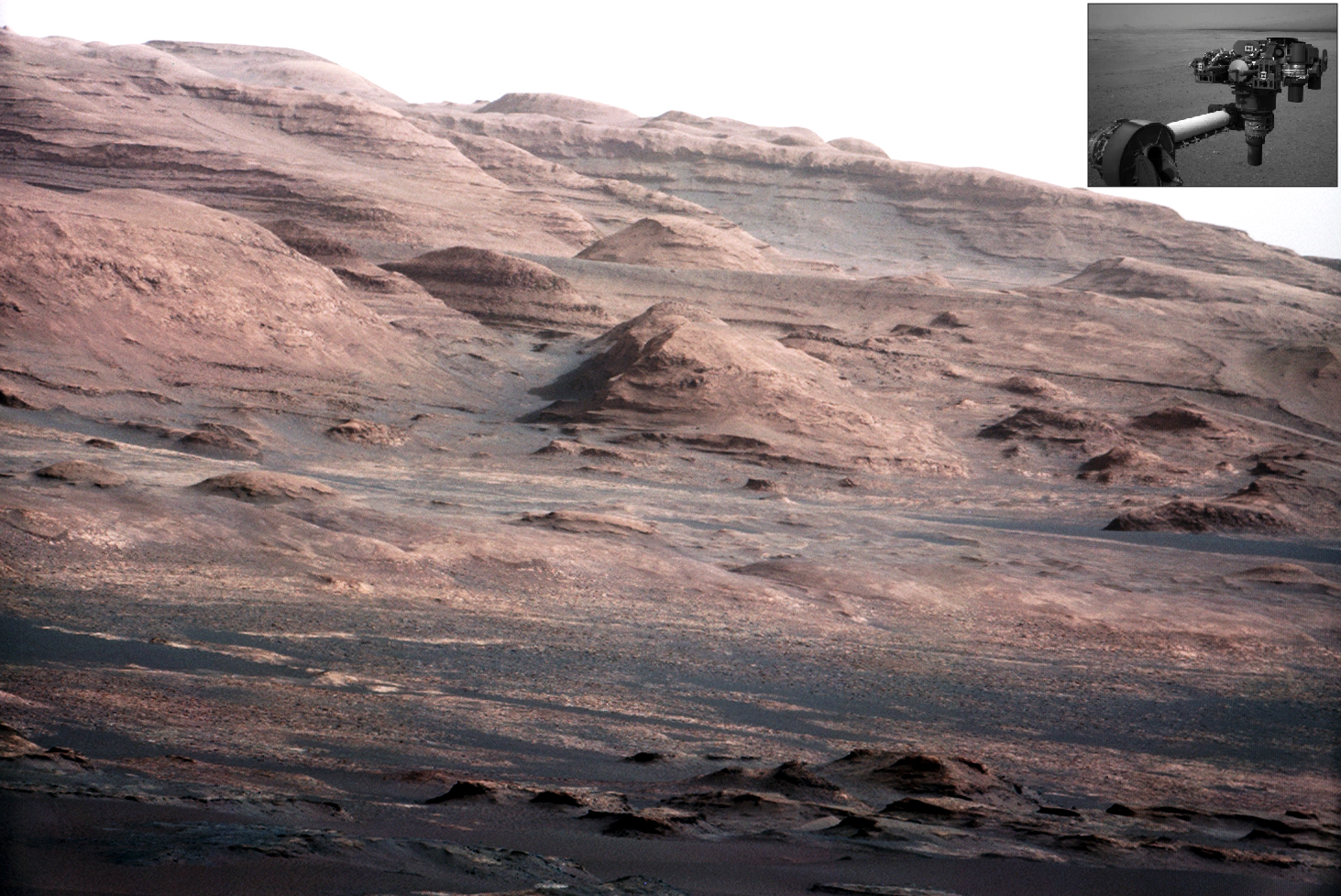
Image Credit: NASA/JPL-Caltech/MSSS
Planetary scientists have recently discovered that sand dunes on Mars are actively moving by using a satellite remote-sensing method that was first developed by my colleague, Marius Necsoiu, to estimate the speed at which the Great Kobuk Sand Dunes are moving in Kobuk Valley National Park, Alaska.

Image Credits: Background: ASTER image by NASA/USGS/METI; Inset: SPOT image superimposed with migration vectors estimated by Marius Necsoiu for the 2003-2008 timeframe.
Because the best photographic images of the Martian surface are relatively few, we are just barely beginning to have enough data to compare images of a single planetary scene at multiple points in time. Some people talk about Mars as if it is a dead planet, but when you look closely at the planet for a long enough period of time, you'll start to notice that many physical processes are happening. In the recent past, planetary scientists thought sand dunes on Mars were frozen in time, but since 2008 we've known that this just isn't true. Mars is alive, not dead!
To help prepare humankind for the exploration of other worlds and expand understanding of extraterrestrial geologic processes, planetary scientists study the extreme landscapes of Earth that are most similar to other planets or their moons. In the scientific discipline of comparative planetology, the features and processes that are observed on extraterrestrial planetary bodies in our solar system are compared to similar features and processes on Earth because our own landscapes are more easily accessible for detailed study and analysis-we call these places "planetary analogs" because they are reasonably comparable to planetary landscapes. This is why my team of researchers began conducting satellite remote-sensing investigations of the Great Kobuk Sand Dunes in 2008, and then traveled to this planetary analog site to perform geophysical, meteorological, and geomorphological field research for 2 weeks in 2010.
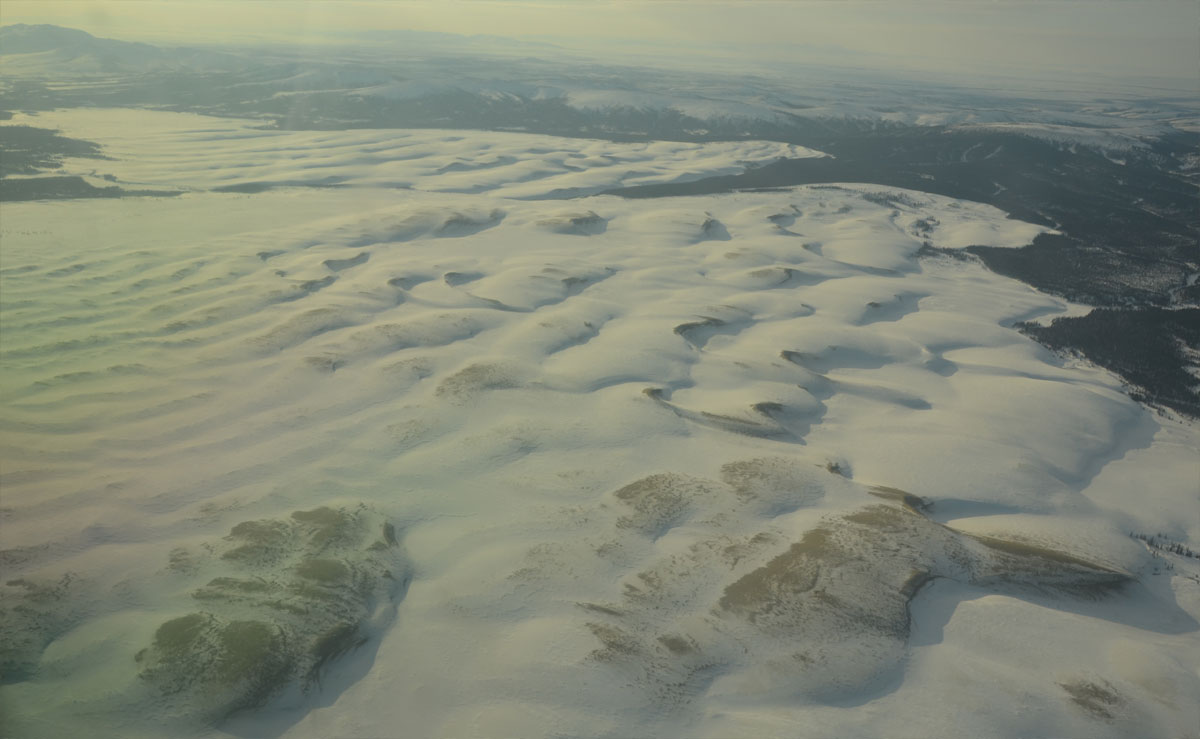
Image Credit: National Park Service / M. Johnson
Sand dunes in Kobuk Valley National Park move excruciatingly slow, just like dunes on Mars. Sand dunes near Earth's equator don't move slowly like this, and the smaller the dune, the faster it moves. Strangely, our remote-sensing data analyses suggest that the largest dunes in Kobuk Valley may actually move faster than the smallest ones! Why do arctic dunes behave differently than warm-climate dunes, and do any Martian dunes behave like Earth's arctic dunes? To better understand why cold dunes move so slowly, we used tools like shallow boreholes, ground temperature sensors and ground-penetrating radar and multielectrode resistivity surveys to peer inside the sand dunes in Kobuk Valley in late March 2010, when the weather was cold. When I say it was cold, I mean the average daily temperature was 6 degrees Fahrenheit. This is cold enough that the seasonally frozen active layer was at its maximum annual thickness, and we assumed the dunes likely would be frozen to their base. The annual average temperature in Kobuk Valley is 25 degrees Fahrenheit, which is cold enough for the dunes to be surrounded by widespread, discontinuous permafrost.

Image Credits: NASA/SwRI®
At the Great Kobuk Sand Dunes, lowland areas between dunes (called interdunes), small dunes, downwind lee slopes of large dunes, and most of the upwind stoss slopes of large dunes are snow-covered for approximately two-thirds of the year, and only the elevated crests of the largest dunes remain exposed to wind throughout much of the winter season. We think this seasonal disconnect between the dune sand and winds may be why large dunes move faster than small dunes in Kobuk Valley.
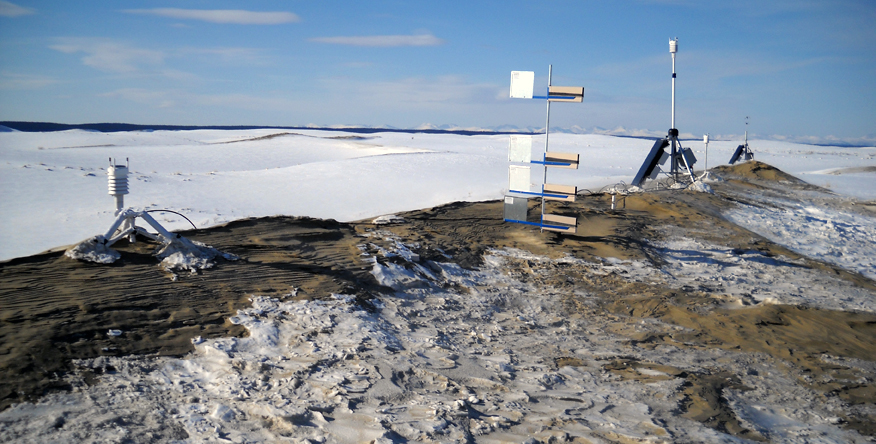
Image Credit: NASA/SwRI®/D.M. Hooper
Polar dunes on Mars experience a similar disconnection during Martian winter when they are covered with carbon dioxide and water frost.
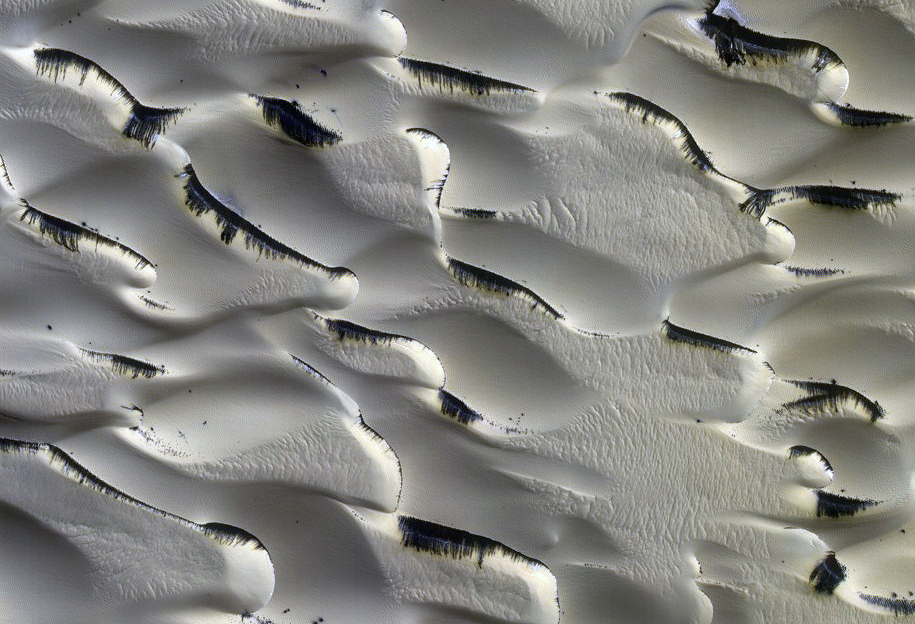
Image Credit: NASA/JPL/University of Arizona
Electrical resistivity surveys of the sand dunes showed that the seasonally frozen active layer was approximately 13 feet thick beneath dune crests, and less than 7 feet thick beneath interdunes. The dunes are composed of fine sand, through which liquid water should permeate and drain rapidly. But, we found groundwater in boreholes below the frozen interdunes and no permafrost. Despite the annual average temperature of 25 degrees Fahrenheit, liquid water persists year-round beneath the dunes. Geophysical data suggest that the regional groundwater beneath the dunes is relatively flat-lying, like a table top, and approaches the surface within the interdunes; however, the data also strongly suggest that there is a thin layer of liquid water just below the frozen active layer, which mirrors dune elevation and relief (i.e., topography). This liquid water perched high in the dune system was curious and unexpected, and our research team has spent considerable time looking into possible explanations for it. The presence and topographic mirroring behavior of the near-surface liquid water layer suggests that it is perched on a thermally controlled, low-permeability barrier to downward water flow. This barrier would have had to have developed in dynamic equilibrium with slow dune migration, and eroding remnants of it may be visible on stoss slopes when not covered by snow.


We suggest that this low-permeability barrier develops throughout the Great Kobuk Sand Dunes through cryodesiccation, or freeze-drying. Cryodesiccation can produce both ice lenses and calcium-carbonate cements, called calcrete, at the base of the active layer, where upward freezing from a permafrost table or downward freezing from the land surface occur. A cryogenic barrier could be composed of an ice-rich layer that lies perpendicular to the direction of heat flow at the base of the active layer; cryogenic cement; and other clay-sized particles preferentially deposited through cryogenic processes during annual freeze-up. Supporting the calcrete hypotheses, carbonate grains comprise 7% of the dune sand, and widespread calcrete has been observed by others when snow cover is absent.
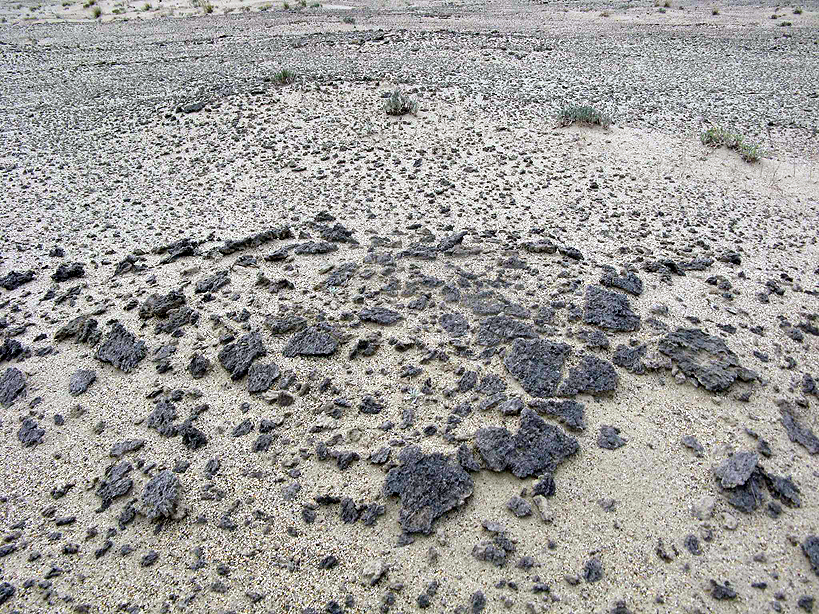
Image Credit: Jorgenson, M.T., J.E. Roth, P.F. Miller, M.J. Macander, M.S. Duffy, A.F. Wells, G.V. Frost and E.R. Pullman. (2009) An Ecological Land Survey and Landcover Map of the Arctic Network. Natural Resource Technical Report NPS/ARCN/NRTR-2009/270. Fort Collins, Colorado, U.S. National Park Service, 307 pp. + GIS database.
We think these cold-climate sand dunes move slowly because seasonal snow cover acts like a windshield above the sand, and seasonally frozen water in the active layer immobilizes most of the sand during long winters. Warm-season rains also play a role in minimizing the sand that is available to be lofted by wind. Finally, the regional aquifer beneath the interdunes and the perched water high in the dune uplands both make the sand sticky, like moist beach sand that can be molded when you're building a sand castle. The Great Kobuk Sand Dunes are a "wet" sand dune system. Although they are influenced by a semi-arid climate, there is a lot of near-surface water trapped above the near-continuous permafrost in this region. These dunes provide an excellent planetary analog site for studying how the water cycle influences sand transport under conditions similar to those of Martian polar deserts, especially ancient Mars, which was a little warmer and wetter than the planet is today.
While we were conducting this planetary analog study at the Great Kobuk Sand Dunes, my colleague, Don Hooper, noticed that several meltwater debris flows were forming on some west-facing slopes of the dunes. Debris flows with gully or erosion tracks also appear on the slopes of several dune fields on Mars! Our new observation was important because it indicated that another planetary analog process was happening at the dunes, and only a few minutes of above-freezing temperatures are needed to melt water and mobilize sand transport down steep slopes. Small debris flows originate near dune crests, become channelized down lee slopes, and terminate with a fan-shaped deposit. We need to conduct new surveys to measure debris flow and gully morphologies, slope angle, solar radiation, subsurface temperature and moisture profiles and other variables to validate our conceptual model of the processes that control debris flow formation on the Great Kobuk Sand Dunes.

Image Credits: NASA/SwRI/C.L. Dinwiddie and D.E. Stillman
It is important for in-depth investigations of the Great Kobuk Sand Dunes to continue while the planetary analogy is still defensible, given the anticipated effects of a warming climate on the permafrost of this region. This planetary analog site may be less beneficial in future decades than it is today.
Dr. Cynthia L. Dinwiddie
Dr. Dinwiddie is a hydrogeologist at Southwest Research Institute® who develops integrated geophysical and remote-sensing characterization methodologies to investigate hydrologic processes on Earth and Mars. Recently, her work has focused on understanding the phase state of water in subarctic aeolian and thermokarstic environments, parameterizating landscape-scale models for assessing risk of subarctic slope instability under changing climate, developing soil moisture and soil freezing characteristic curves for Martian soil simulants and terrestrial sands, and documenting the characteristics of Fe-oxide concretions that form through preferential flow fingering after a fluvial sandstone reservoir transitions from fully to variably saturated. She has broad expertise in mechanical engineering, environmental science, and the mathematical sciences, and 13 years experience in organizing and conducting field investigations in remote environments.
As a petrophysicist, she studies subsurface heterogeneity of terrestrial planetary bodies and works with field and laboratory instrumentation and geophysical techniques to quantify hydrologic property distributions. She has analyzed primary and secondary heterogeneities within shoreface and fluvial sandstones, active sand dunes and sand sheets, organic- and ice-rich polygonal soils, volcanic ignimbrites, and fluvially reworked volcaniclastics. Her recent work has broadened to developing an understanding of the heterogeneities that form within and the related hydrologic performance of engineered materials, which include engineered soil cover barriers used for land disposal and cementitious grout monoliths used to stabilize high-level radioactive waste tanks.
Dr. Dinwiddie was honored in 2010 as a rising star by San Antonio Business Journal's 40 under 40 listing, and she has received both the 2007 Rossiter W. Raymond Memorial Award and the 2007 Alfred Noble Prize. Dr. Dinwiddie has authored and coauthored 17 peer-reviewed journal articles, and has served as a panel reviewer for the National Aeronautics and Space Administration (NASA) and the National Science Foundation, as a technical reviewer for NASA grant and technology development proposals, and as a peer reviewer for Earth Surface Processes and Landforms, Journal of Hydrology, Journal of Hydrologic Engineering, Transport in Porous Media, Ground Water, and Environmental Science & Technology.
Acknowledgements
This work was supported by NASA Mars Fundamental Research Program grant NNX08AN65G and by Southwest Research Institute®'s internal research and development projects 20.R8002 and 20.R8136. Colleagues who have contributed to these studies include Marius Necsoiu, David E. Stillman, Ronald N. McGinnis, Donald M. Hooper, Timothy I. Michaels, Kevin J. Bjella, Gary R. Walter, Stuart A. Stothoff, Sébastien Leprince and Robert E. Grimm.
I am grateful to Seth Kantner for his invaluable field knowledge and support, Clarence Wood for use of his private allotment, Jim Kincaid and Alvin Williams for their logistical support, and the National Park Service (NPS) for research permit KOVA-2010-SCI-0001.
Disclaimer
Any opinions, findings, and conclusions or recommendations expressed in this blog are those of the author and do not necessarily reflect the official positions or views of the National Aeronautics and Space Administration (NASA) or of the NPS.
